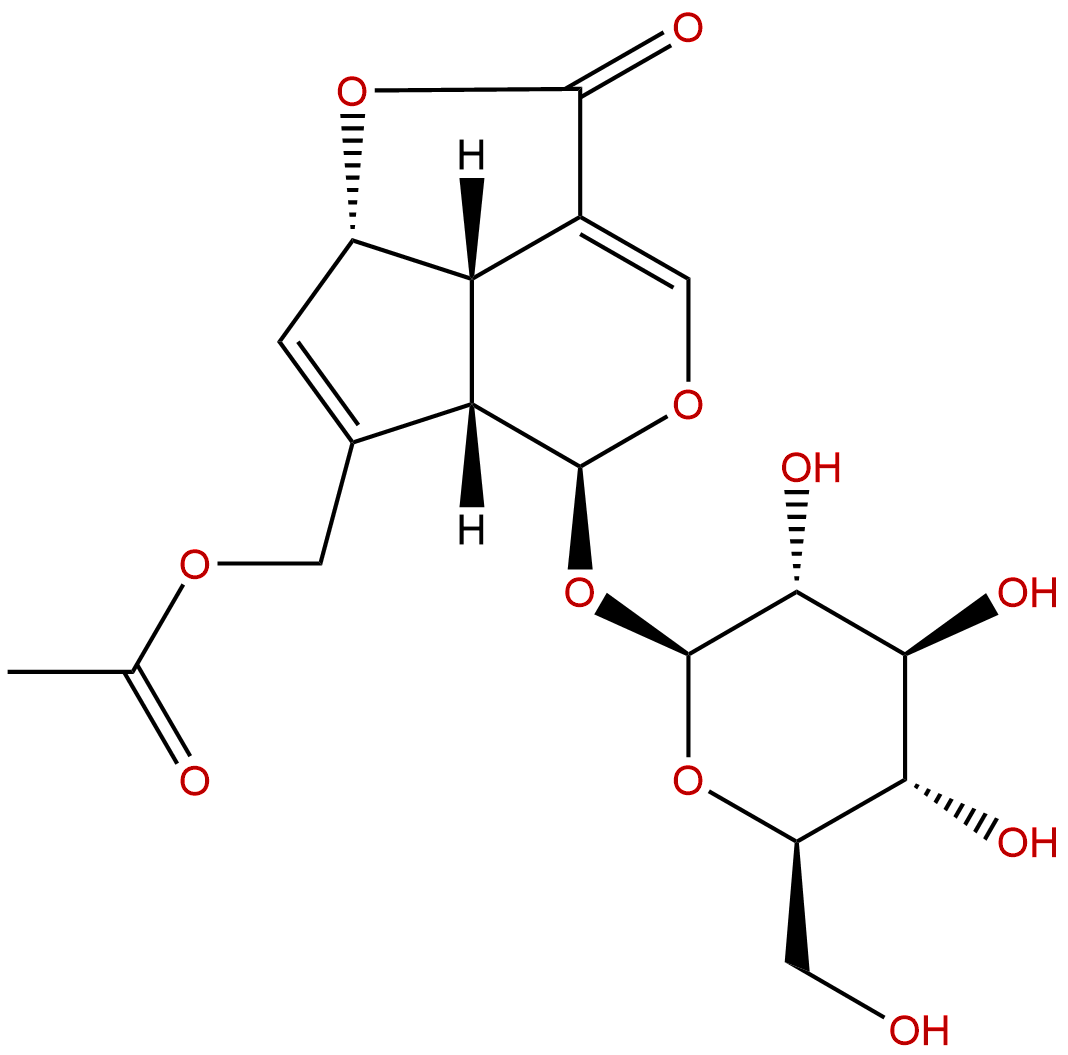
AsperulosideCAS No.:14259-45-1
|
||||||||||
 |
|
|
||||||||

| Catalogue No.: | BP1773 |
| Formula: | C18H22O11 |
| Mol Weight: | 414.363 |
Product name: Asperuloside
Synonym name: Rubichloric acid
Catalogue No.: BP1773
Cas No.: 14259-45-1
Formula: C18H22O11
Mol Weight: 414.363
Botanical Source: Asperula spp.; Daphniphyllum macropodum
Physical Description: Powder
Type of Compound: Iridoids
Purity: 95%~99%
Analysis Method: HPLC-DAD or/and HPLC-ELSD
Identification Method: Mass, NMR
Packing: Brown vial or HDPE plastic bottle
The product could be supplied from milligrams to grams. Inquire for bulk scale.
We provide solution to improve the water-solubility of compounds, thereby facilitating the variety of activity tests and clinic uses.
For Reference Standard and R&D, Not for Human Use Directly.
Description:
Asperuloside exerts its anti-inflammatory effect in correlation with inhibition of a pro-inflammatory mediator through suppressing nuclear factor kappa-B (NF-κB) nuclear translocation and MAPK phosphorylation in a dose-dependent manner. Chronic administration of Asperuloside stimulates anti-obesity and anti-metabolic syndrome activity in HFD-fed rats across several organs, similar to Eucommia leaf extract (ELE) administration.
References:
Int. Immunopharmacol., 2016 Feb;31:109-15.
Pretreatment with the compound asperuloside decreases acute lung injury via inhibiting MAPK and NF-κB signaling in a murine model.
Asperuloside, an iridoid glycoside found in Herba Paederiae, is a component from traditional Chinese herbal medicine.
METHODS AND RESULTS:
In this study, we aimed to investigate the protective effects and potential mechanisms of Asperuloside action on inflammatory responses in lipopolysaccharide (LPS)-stimulated Raw 264.7 cells and an LPS-induced lung injury model. The pro-inflammatory cytokines and signaling pathways were measured by enzyme-linked immunosorbent assays (ELISA) and Western blotting to determine the effects of Asperuloside. We found that Asperuloside can significantly downregulate tumor necrosis factor alpha (TNF-α), interleukin (IL)-1β, and IL-6 levels in vitro and in vivo, and treatment with Asperuloside significantly reduced the lung wet-to-dry weight, histological alterations and myeloperoxidase activity in a murine model of LPS-induced acute lung injury (ALI). In addition, Western blot analysis that pretreatment with Asperuloside remarkably blunted the phosphorylation of inhibitor of nuclear factor kappa-B (IκBα), extracellular signal-related kinases 1 and 2 (ERK1/2), c-Jun. N-terminal kinase (JNK) and p38 mitogen-activated protein kinase (p38MAPK) in LPS-stimulated inflammation.
CONCLUSIONS:
These results indicate that Asperuloside exerts its anti-inflammatory effect in correlation with inhibition of a pro-inflammatory mediator through suppressing nuclear factor kappa-B (NF-κB) nuclear translocation and MAPK phosphorylation in a dose-dependent manner.
J Nutr Sci. 2012 Sep 5;1:e10.
Asperuloside stimulates metabolic function in rats across several organs under high-fat diet conditions, acting like the major ingredient of Eucommia leaves with anti-obesity activity.
Eucommia leaves (Eucommia ulmoides Oliver) contain chlorogenic acid (a caffeic acid derivative) and geniposidic acid and Asperuloside (ASP), iridoid glucosides used in beverages.
METHODS AND RESULTS:
We used a metabolic syndrome rat model, produced by feeding a 35 % high-fat diet (HFD), to examine potential anti-obesity and anti-metabolic syndrome effects and mechanisms of chronic administration of ASP. These effects were compared with Eucommia leaf extract (ELE), the positive control, which exhibits anti-obesity effects. A total of six rats were studied for 3 months in five groups. ASP suppressed body weight, visceral fat weight, food intake and circulating levels of glucose, insulin and lipids, and increased the plasma adiponectin level in rats on a HFD. These effects are similar to those of ELE, except for the influence on the plasma glucose level. RT-PCR studies showed that ASP (like ELE with known anti-obesity effects) diminished isocitrate dehydrogenase 3α, NADH dehydrogenase flavoprotein 1 (Comp I) mRNA and fatty acid synthase levels (white adipose tissue), increased carnitine palmitoyltransferase 1α and acyl-CoA dehydrogenase, very-long-chain mRNA levels (liver), and increased Glut4, citrate synthase, isocitrate dehydrogenase 3α, succinyl CoA synthase, peroxisomal 3-ketoacyl-CoA thiolase, dihydrolipoamide succinyl transferase and succinate dehydrogenase mRNA levels (skeletal muscle) under HFD conditions. Interestingly, ASP administration resulted in significantly increased mRNA levels of uncoupling protein 1 (UCP1) in the brown adipose tissue of HFD-fed rats; ELE did not affect the expression of UCP1. The increased expression of UCP1 may be negated by many ingredients other than ASP in the ELE.
CONCLUSIONS:
These findings suggest that chronic administration of ASP stimulates anti-obesity and anti-metabolic syndrome activity in HFD-fed rats across several organs, similar to ELE administration; thus, ASP may be an important ingredient of ELE.
HPLC of Asperuloside
